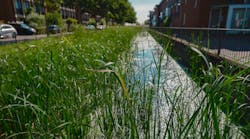The New York Times reports in “Taps Start to Run Dry in Brazil’s Largest City” that São Paulo, which is the world’s 12th largest city and an important industrial center, is experiencing its worst water crisis in nearly a century. The water pressure has been lowered. Rationing has begun and is expected to increase, creating days when running water is not available, and that is only a best-case scenario.
Many factors are implicated, including pollution and population growth. Deforestation is thought to be a main contributor, because by capturing and containing water, trees and forests promote the conditions favorable to continued rainfall. They also allow for cooler temperatures that can offset the need for air conditioning, which is important since producing electricity is water-intensive. It is troubling that this vicious cycle of drought and heat is happening in territory fed by many rivers, including the Amazon. One can hope it will serve as a cautionary tale.
The Times article says it is estimated that more than 30% of São Paulo’s water “is lost to leaks and pilfering.” Leaks and non-revenue water challenge water utilities in the US too, but in spite of daunting dollar amounts required to fix the problems, it is nice to have good news to share. This issue of Water Efficiency spotlights a lot of proactive technology being implemented, as well as tools to change thinking and behavior.
The New York Times reports in
“Taps Start to Run Dry in Brazil’s Largest City” that São Paulo, which is the world’s 12th largest city and an important industrial center, is experiencing its worst water crisis in nearly a century. The water pressure has been lowered. Rationing has begun and is expected to increase, creating days when running water is not available, and that is only a best-case scenario.
Many factors are implicated, including pollution and population growth. Deforestation is thought to be a main contributor, because by capturing and containing water, trees and forests promote the conditions favorable to continued rainfall. They also allow for cooler temperatures that can offset the need for air conditioning, which is important since producing electricity is water-intensive. It is troubling that this vicious cycle of drought and heat is happening in territory fed by many rivers, including the Amazon. One can hope it will serve as a cautionary tale.
The Times article says it is estimated that more than 30% of São Paulo’s water “is lost to leaks and pilfering.” Leaks and non-revenue water challenge water utilities in the US too, but in spite of daunting dollar amounts required to fix the problems, it is nice to have good news to share. This issue of
Water Efficiency spotlights a lot of proactive technology being implemented, as well as tools to change thinking and behavior.
[text_ad]
California is another drought-ridden region, and recent rains haven’t done enough, but fortunately CA has places like California State University, Fresno (CSU–Fresno), home of California Water Institute, the International Center for Water Technology, and the Center for Irrigation Technology. The CSU–Fresno campus is featured in William Atkinson’s article
“New Technology for Smart Educational Facility Landscapes.” The college has agriculture and viniculture departments (I have enjoyed a bottle of their Pinot Gris), yet in the last five years has reduced its farm watering by 40% with micro sprinklers and drip irrigation.
In
“Leak Detection is Not Wasted” Carol Brzozowski describes a number of means to detect leaks, and she discusses why utilities may choose to outsource leak detection programs, or conversely, when it is best to have them in house.
Ed Ritchie considers the ways SCADA systems help alert municipalities to leaks and lost water in
“SCADA Update.” Ratepayers play a part too, and Lori Lovely’s article,
“Perspectives on AMI Preparation” mentions how information is needed to work toward goals, citing smartphone apps that help customers with water budgeting. AMI allows for a tremendous amount of communication on both sides of the meter. AMI can allow shut off valves to be integrated with GIS and weather data to turn off sprinklers when it is raining.
The Times article about São Paulo examines communication failures between the state run water utility and city residents that can only be exacerbating the problems; what is hidden or unclear cannot be dealt with.
We have an article,
“The Ultimate Water Efficiency Challenge,” submitted by the National Resource Defense Council, that talks about NRDC’s new website,
Cutting Our Losses: State Policies to Track and Reduce Leakage form Public Water Systems, which is designed to unite the public over buried water leaks throughout our nation, and to facilitate states and utilities learning from one another.
Space will not allow me to summarize all the articles we are running, but I want to point out Linda Robinson’s sweeping view of the Magic Valley in south central Idaho.
“The Ditches That Made Magic” is a testimony to over 100 years of hard work that have made and kept a landscape productive. The article also touches on the vulnerabilities of our times, as everywhere on earth there are changes. With population increases, climate instability, and new understanding about watersheds, water management is requiring new attitudes, new regulations, new tools, and new courage.
California is another drought-ridden region, and recent rains haven’t done enough, but fortunately CA has places like California State University, Fresno (CSU–Fresno), home of California Water Institute, the International Center for Water Technology, and the Center for Irrigation Technology. The CSU–Fresno campus is featured in William Atkinson’s article “New Technology for Smart Educational Facility Landscapes.” The college has agriculture and viniculture departments (I have enjoyed a bottle of their Pinot Gris), yet in the last five years has reduced its farm watering by 40% with micro sprinklers and drip irrigation.
In “Leak Detection is Not Wasted” Carol Brzozowski describes a number of means to detect leaks, and she discusses why utilities may choose to outsource leak detection programs, or conversely, when it is best to have them in house.
Ed Ritchie considers the ways SCADA systems help alert municipalities to leaks and lost water in “SCADA Update.” Ratepayers play a part too, and Lori Lovely’s article, “Perspectives on AMI Preparation” mentions how information is needed to work toward goals, citing smartphone apps that help customers with water budgeting. AMI allows for a tremendous amount of communication on both sides of the meter. AMI can allow shut off valves to be integrated with GIS and weather data to turn off sprinklers when it is raining.
The Times article about São Paulo examines communication failures between the state run water utility and city residents that can only be exacerbating the problems; what is hidden or unclear cannot be dealt with.
We have an article, “The Ultimate Water Efficiency Challenge,” submitted by the National Resource Defense Council, that talks about NRDC’s new website, Cutting Our Losses: State Policies to Track and Reduce Leakage form Public Water Systems, which is designed to unite the public over buried water leaks throughout our nation, and to facilitate states and utilities learning from one another.
Space will not allow me to summarize all the articles we are running, but I want to point out Linda Robinson’s sweeping view of the Magic Valley in south central Idaho. “The Ditches That Made Magic” is a testimony to over 100 years of hard work that have made and kept a landscape productive. The article also touches on the vulnerabilities of our times, as everywhere on earth there are changes. With population increases, climate instability, and new understanding about watersheds, water management is requiring new attitudes, new regulations, new tools, and new courage.


